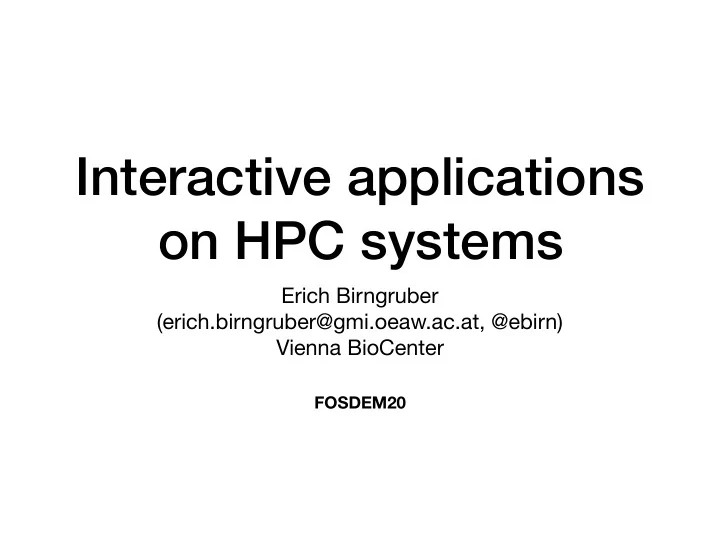

Interactive applications on HPC systems Erich Birngruber (erich.birngruber@gmi.oeaw.ac.at, @ebirn) Vienna BioCenter FOSDEM20
Interactive applications on HPC systems Erich Birngruber (erich.birngruber@gmi.oeaw.ac.at, @ebirn) Vienna BioCenter FOSDEM20 .
sh$ not good enough? ❓
XPRA
XPRA • https://xpra.org/ • “screen for X11” • Allows disconnect / re-connect to existing X sessions • Web interface for X11 rendering (HTML5 canvas) • For arbitrary GUI applications • Containerized in SLURM • Custom middleware for job management
Launch XPRA job
XPRA job submitted
XPRA session
XPRA setup batch scheduler IT services submit request launch job middleware connect to xpra client
RStudio
RStudio • https://rstudio.com/ • IDE for R language • Desktop and Web version (RStudio server) • Commercial version for advanced features • RStudio company has become a public benefit company https://blog.rstudio.com/2020/01/29/rstudio-pbc
RStudio setup RStudio server batch scheduler job launcher connect session session
Galaxy • https://galaxyproject.org/ • Web based workflow tool • Tools as building blocks (parameters, input, output) • Tool definitions in XML • Multiple instances: dev - testing - production
Galaxy setup Git repo branches batch scheduler session develop testing production job test job
JupyterHub • https://jupyter.org/ • Web-Based IDE (standalone vs. hub) • Notebooks = Code + Outputs • Interpreters as “Kernels”
JupyterHub setup JupyterHub batch scheduler job hub api session connects proxy
Summary • XPRA Special use cases: X11 applications (Fiji) in Containers • RStudio R (from env modules), web- based IDE • Galaxy pre-configured workflows • JupyterHub Python (per-user kernels), plugins
Others • OpenOnDemand: interactive/remote desktop portal https://openondemand.org/ • Apache Zeppelin: data exploration “notebooks” https://zeppelin.apache.org/ • Eclipse Che: cloud-based editor https://www.eclipse.org/che/
Then this happened 😴
What is wrong? What’s Wrong with Computational Notebooks? Pain Points, Needs, and Design Opportunities Souti Chattopadhyay 1 , Ishita Prasad 2 , Austin Z. Henley 3 , Anita Sarma 1 , Titus Barik 2 Oregon State University 1 , Microsoft 2 , University of Tennessee-Knoxville 3 {chattops, anita.sarma}@oregonstate.edu , {ishita.prasad, titus.barik}@microsoft.com , azh@utk.edu Azure, 1 Databricks, 2 Colab, 3 Jupyter, 4 and nteract. 5 While ABSTRACT Computational notebooks—such as Azure, Databricks, and originally intended for exploring and constructing computa- Jupyter—are a popular, interactive paradigm for data scien- tional narratives [29, 31], data scientists are now increasingly tists to author code, analyze data, and interleave visualiza- orchestrating more of their activities within this paradigm [33]: through long-running statistical models, transforming data at tions, all within a single document. Nevertheless, as data scale, collaborating with others, and executing notebooks di- scientists incorporate more of their activities into notebooks, rectly in production pipelines. But as data scientists try to do they encounter unexpected difficulties, or pain points, that so, they encounter unexpected difficulties—pain points—from impact their productivity and disrupt their workflow. Through limitations in affordances and features in the notebooks, which a systematic, mixed-methods study using semi-structured in- impact their productivity and disrupt their workflow. terviews ( n = 20 ) and survey ( n = 156 ) with data scientists, we catalog nine pain points when working with notebooks. To investigate the pain points and needs of data scientists Our findings suggest that data scientists face numerous pain who work in computational notebooks, across multiple note- points throughout the entire workflow—from setting up note- book environments, we conducted a systematic mixed-method books to deploying to production—across many notebook study using field observations, semi-structured interviews, and environments. Our data scientists report essential notebook a confirmation survey with data science practitioners. While requirements, such as supporting data exploration and visual- prior work has studied specific facets of difficulties in note- ization. The results of our study inform and inspire the design books [24, 17], such as versioning [18, 19] or cleaning unused of computational notebooks. code [13, 34], the central contribution of this paper is a taxon- omy of validated pain points across data scientists’ notebook Author Keywords activities. Computational notebooks; challenges; data science; interviews; pain points; survey Our findings identify that data scientists face considerable pain points through the entire analytics workflow—from set- CCS Concepts ting up the notebook to deploying to production—across
References • XPRA https://xpra.org/ • RStudio https://rstudio.com/ • Jupyterhub https://jupyter.org/hub • Galaxy https://galaxyproject.org/ • What is wrong with computational notebooks? http://web.eecs.utk.edu/~azh/blog/notebookpainpoints.html
Recommend
More recommend